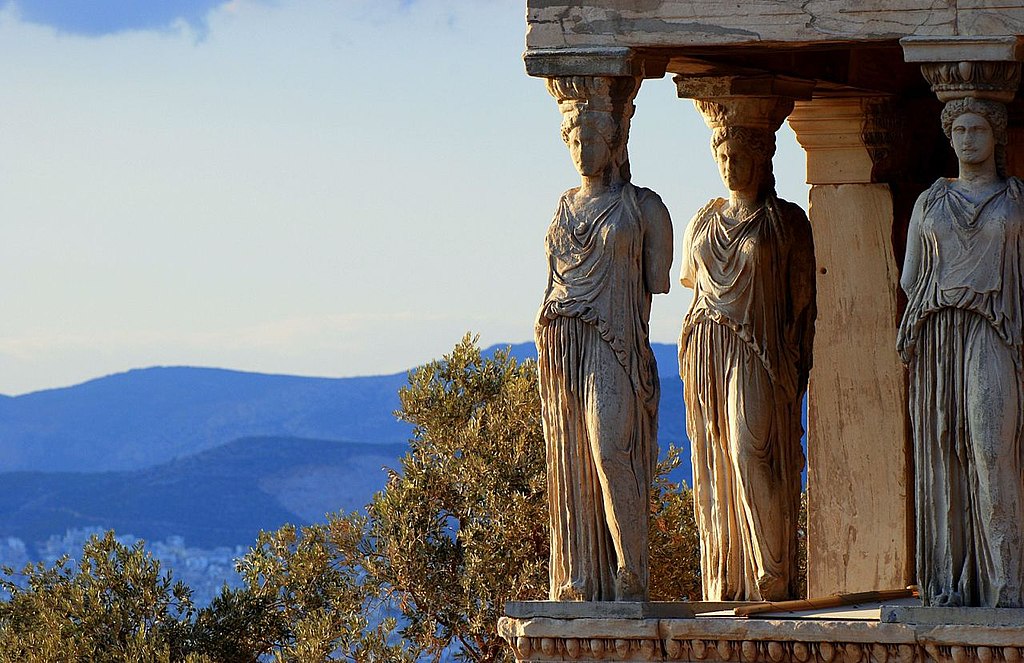Understanding “history” obliges us to step out of our own world and into another. It beckons us to acknowledge the possibility that ways of being utterly alien to our own held sway in other places and at other times. Historian Greg Anderson argues here that the modern West rests on divisions between the human-made and nature, between humans and other creatures, and between the material and immaterial. Ancient Greeks or the people of Abya Yala, by contrast, understood their world as an ecosystem in which such separations were inconceivable. When we insist on understanding other worlds on our own terms, we not only commit a type of intellectual imperialism. We deny ourselves rich lessons in how to lead a more ethical and sustainable existence.
We tell ourselves that there is just one ultimate reality out there, a single fixed world of experience ruled by universal laws of science and nature. But the historical record suggests otherwise.
If we “decolonize” modern historical thinking, allowing the peoples we study to decide for themselves what was true and real in their experience, our picture of the larger human story will dramatically change. We will begin to see how other “real worlds” are entirely possible. We will see how humans have always lived in a “pluriverse” of many worlds, not in a universe of just one. And this new vision of the past will help transform the way we see the present and the future.
Different Truths to Live By
Every human community tells its own stories about the ultimate order of things, whether by way of traditional oral tales, parables in sacred texts, or equations in physics journals. All are stories that capture essential truths of existence, about the origins of the world, relations between humans and gods, and the nature of life and death, good and evil, personhood and kinship, and so on.
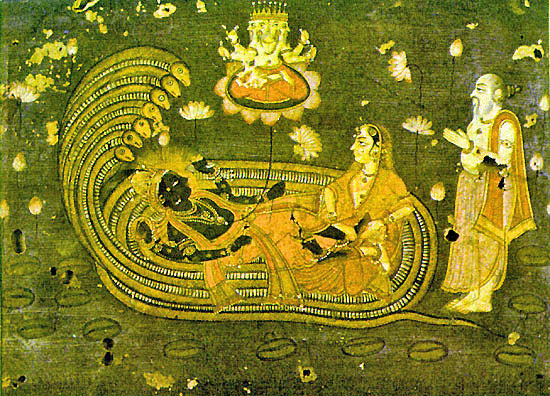
Together, such stories end up producing something like a common-sense knowledge of the foundations of reality, a shared model of the world to live by. And this model duly informs the various norms, values, and practices on which the life and health of the community is staked.
When one then surveys the different models of reality that communities have lived by, one is immediately struck by their diversity. Different ways of life have been staked upon radically different versions of the “real world.” To get a sense of this diversity, we can compare our modern western model with two non-modern examples.
In the modern West, we are socialized to think of reality as a kind of vast abstract space that contains multitudes of individual objects, all of which obey timeless universal “laws” of science and nature. To be real to us, objects must be either be observable material things, like sand grains, persons, and planets, or things that are observable through their effects on matter, like gravity and wind.
Hence, immaterial unobservable things like gods and demons, heavens and hells, are not considered real in the same way. In the end, they are just beliefs, mere subjective ideas that exist only in the realm of the human mind. By contrast, a real phenomenon must exist objectively, independent of human thought, defined by its own properties.

So, what real things in our world are the most important? The short answer is human things, like people and cities, societies and economies, arts and sciences. As we see it, reality inevitably divides itself into two orders, a center and a periphery.
At the center is the dominant human order we call “culture,” a kind of world-within-a-world, where human attributes like language, reason, personhood, and free will are all concentrated. On the periphery is the subordinate non-human order we call “nature,” which contains only mute objects and impersonal processes. We humans are thus free to control and exploit this “environment” however we want.
But what does it mean to be human in our world?
It means being an autonomous individual, a person who lives ultimately for oneself. We assume that nature has made every human this way. We assume that it has endowed each of us with all the powers and properties one needs to flourish as a self-reliant being, like reason, self-interest, and rights to life, liberty, and property.
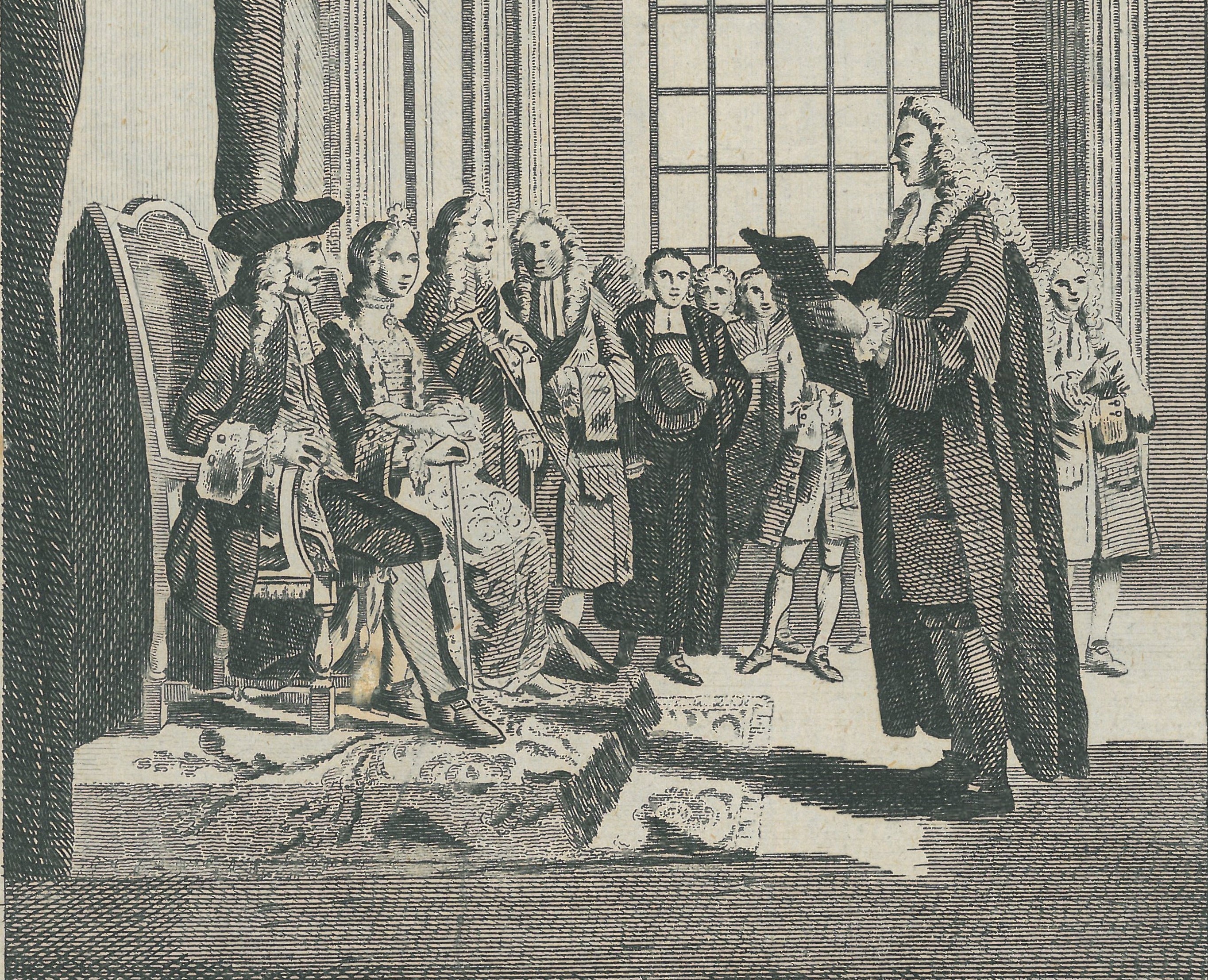
Hence, human communities exist to serve the needs of human individuals, not the other way around. And hence, it makes sense to divide these communities into two distinct spheres, using devices like bills of rights to stop the “public” sphere of government from encroaching on the “private” spaces of society and economy, where individuals should be free to manage and enrich themselves.
Next, consider the world model that the ancient Athenians lived by during the classical period of Greek history (ca. 480-320 BCE).
Of course, we usually know the Athenians as our cultural ancestors, as pioneers of western democracy, philosophy, drama, and so on. We usually think of their polis (“self-governing community”) as a miniature ancient version of a modern democratic nation-state. But their lived reality was nothing like our own.
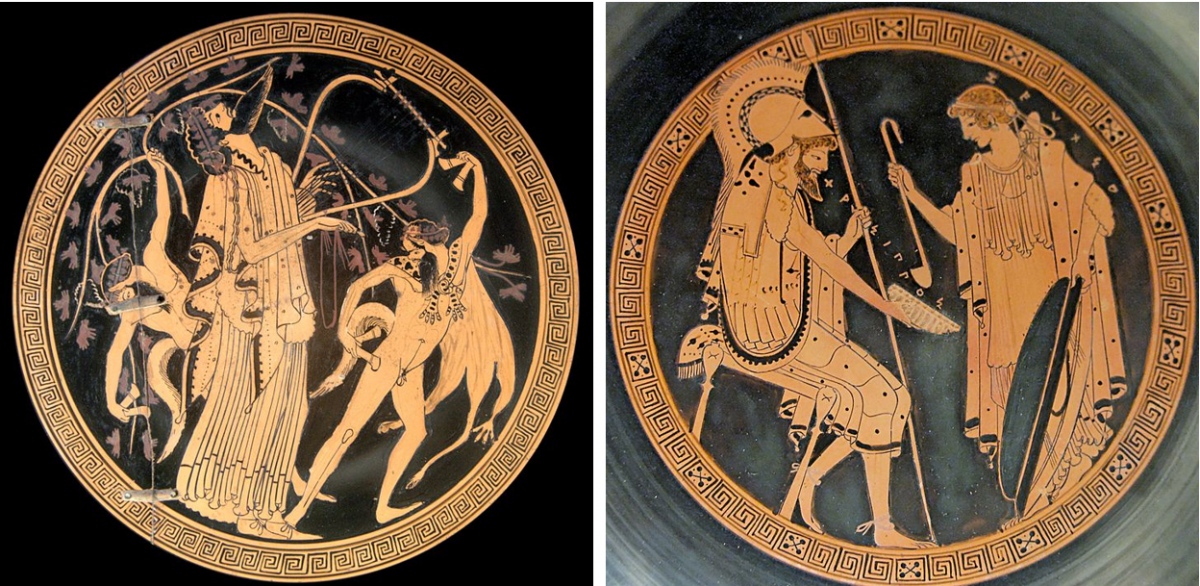
Dionysus and satyrs depicted on the interior of a cup, ca. 480 BCE (left). Depiction of Chrysippos, the illegitimate son of Pelops and the nymph Axioche, and Zeuxo, a water nymph and the daughter of Oceanus, ca. 490 BCE (right).
The real world of the Athenians was alive with things that we would consider immaterial and thus unreal. It pulsated with gods, spirits, nymphs, fates, souls, curses, and numerous mysterious energies and magical forces. Indeed, the most important things in their real world were not humans at all, but gods.
Why? Because gods were immortal living beings who controlled all the things that made life possible, from rainfall, sunlight, and crop harvests to bodily health, family wealth, sea voyages, and military victories.
There were over 200 of these Athenian gods, and they were not remote divinities who observed humans from some celestial elsewhere. They were immediately present in experience, in Athens itself, living in temples, attending sacrifices, mingling with the Athenians at their festivals and dances, continually preserving the well-being of their polis.
In the real world of the Athenians there were no separate orders of culture and nature. Life followed the rhythms of the seasons and the life cycles of plants and animals. Their land of Attica was not just some exploitable “natural environment.” It was a living goddess, a divine earth mother, with whom the Athenians shared an intimate family bond.
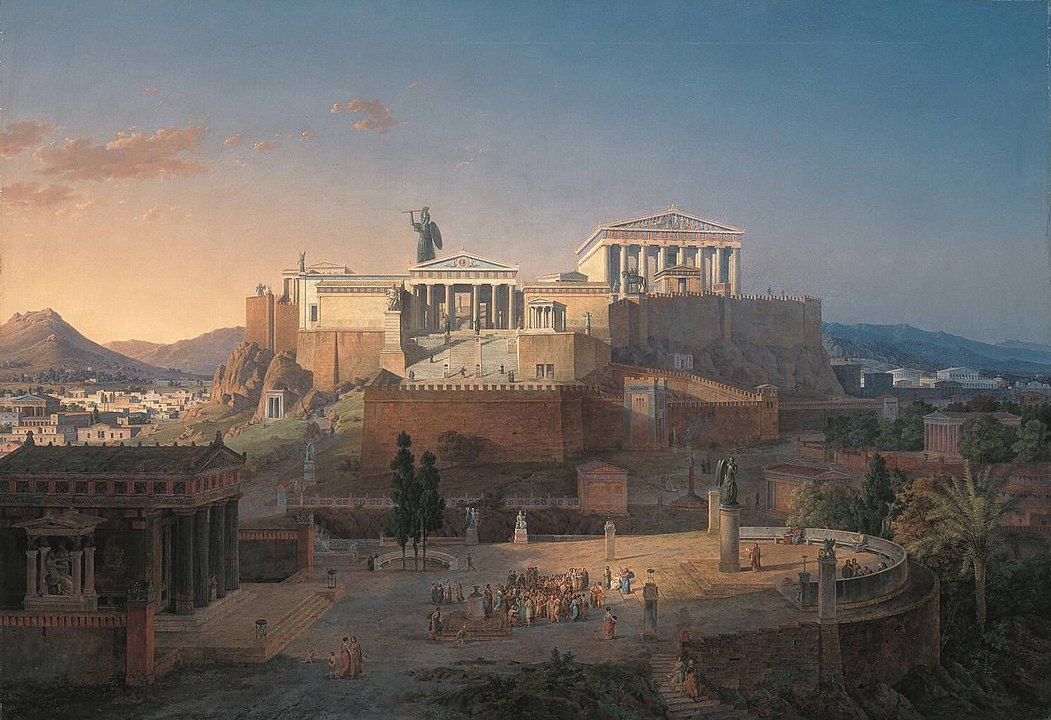
The Acropolis imagined in an 1846 painting by Leo von Klenze.
Mother Attica had given birth to the first Athenians, who sprang from her soil. She had reared these human children herself, giving them the food and life skills necessary to maintain their young polis. And she had nurtured all their descendants ever since with her soils, crops, waters, and other miraculous gifts. In return, the Athenians lavished her with offerings, tended her soils, and protected her from all harm.
In Athenian reality, there was also no such thing as a human individual. Athenians were always defined by the family lineages that produced them. These families were in turn defined by the social body which they all as one comprised, like the cells of a living organism.
They called this social body Demos, the People. And they called their way of life demokratia. This was nothing like our modern democracy. Athenians were not born to live for themselves as individuals. They were born to serve the families and the Demos that had given them life in the first place.
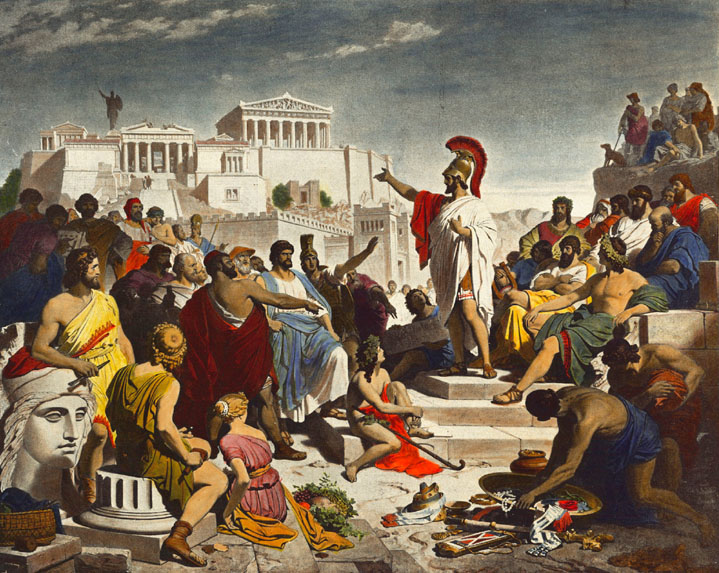
The Athenian politician Pericles delivering his famous funeral oration in front of the Assembly.
In sum, the Athenians lived by truths that were radically different from our own.
Nature had programmed them all to live as integral members of a larger social body. And it had designed them to collaborate with the non-human beings on whom their lives depended, especially their divine earth-mother and their other gods. Life was thus sustained by something like a cosmic ecology, a symbiotic communion of humans and non-humans.
A similar sense of cosmic symbiosis pervades our second non-modern model. This is the timeless reality of Abya Yala (“the land in full maturity”), the name still used by Andean and other indigenous peoples to refer to the lands of “the Americas.”
This world of Abya Yala is not just an abstract space full of animate and inanimate objects existing in and for themselves. According to the founders of Amawtay Wasi (“The House of Wisdom”), an indigenous-led Ecuadorian university that actively promotes a living knowledge of this world, it is rather a fully integrated system of life.
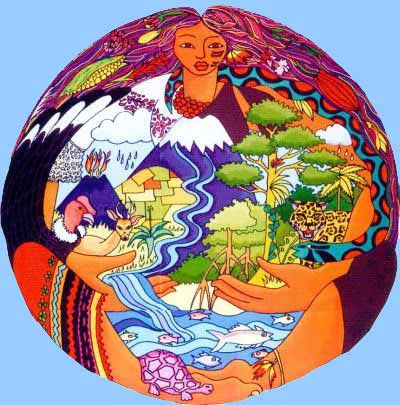
A modern artist’s rendition of Pachamama. (Image by Habacuc).
All things within it are component parts of a balanced whole, from the tiniest insect or pebble to Pachamama herself, the cosmic mistress of the life-giving earth. Here, there is no distinction between the animate and the inanimate, since all things are alive, including stones, water, air, and stars. Hence, there is no such thing in this world as a pure object, since every single thing is an active subject that is expected to contribute to the “good living” of all. Hence too, in this reality, being is essentially relational, not individuated in the modern way.
Things are not defined by innate properties which make them different from other things. They are all products of collaborative and reciprocal relations with other beings on whom their lives depend. So, this reality has no modern-style divisions between contradictory realms of, say, culture and nature, sacred and secular, public and private. Nor does it have true hierarchies, least of all one that elevates humans above non-humans. Humans, like everything else, are just a “thread in the fabric” of being.
The Modern Anomaly
As “exotic” as the realities of ancient Greece and Abya Yala may first seem, relational models of the world have also prevailed in other historical locations, from ancient Egypt and imperial China to precolonial India and Hawai’i.
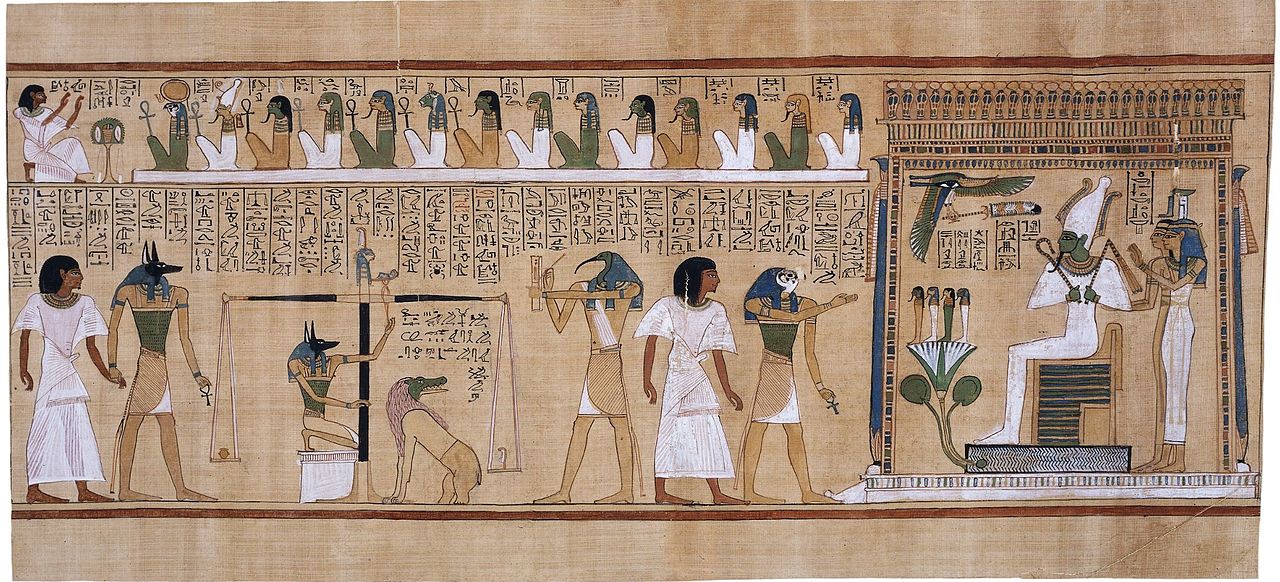
An excerpt from the Book of the Dead reveals the existence of another reality for ancient Egyptians.
In all of these models, immortal beings and forces continually maintained the conditions essential for human flourishing. In all cases, humans were expected to share the world with all manner of non-human beings and things. And in all cases, people were born to serve their families and ecologies, not to live for themselves and compete with one another as individuals.
Our own modern individualist model of reality is in fact the bizarre exception to the rule. As far as one can tell, it is the only reality wherein all real things are made ultimately of matter. It is the only one that is centered on humans, valuing them above all non-humans. And it is the only one where humans are always individuals by their nature.
Presumably, our model is unique because it was shaped by historically novel circumstances in early modern Europe, like the colonial domination of non-Europeans, a new capitalist way of life, the Scientific Revolution, and the Enlightenment.
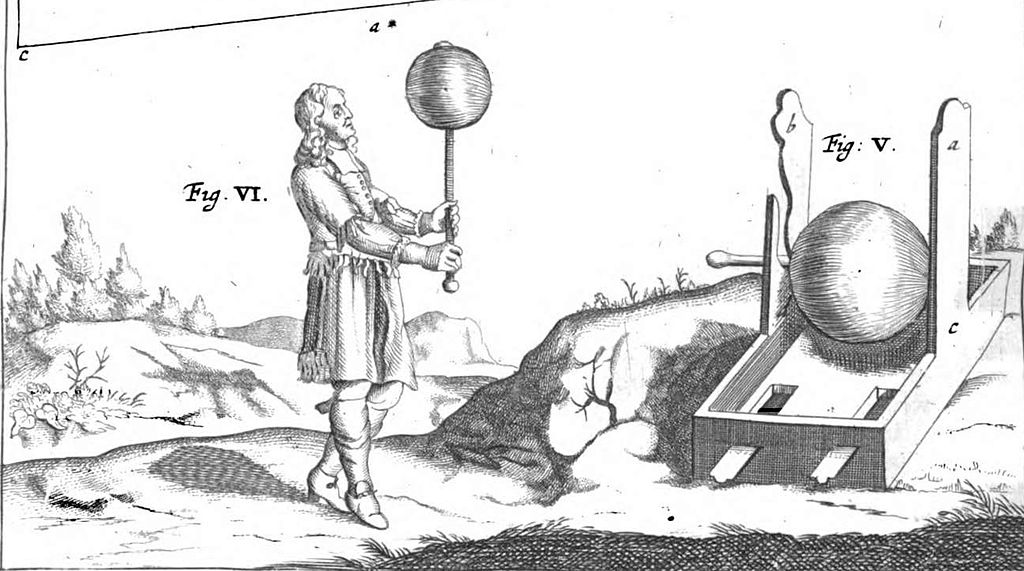
A sketch of Otto von Guericke's experiments on electrostatics with the sulfur globe, 1672.
Yet despite this uniqueness, we take it for granted that our model is timeless, universal, and ultimately “true.” As a product of objective science, it must be the only world that humans have ever experienced, the only real world there is. We modern westerners must be right, and all other historical peoples are just wrong.
It must just be some sort of lucky accident that innumerable non-modern ways of life have actually flourished in history, sustaining countless real lives, because all were apparently based on nothing more than myths, delusions, and other “false” ideas about the true nature of reality.
It would be fair to call these standard modern assumptions chauvinistic, even arrogant. It would also be fair to point out that these kinds of assumptions have had truly devastating historical consequences for others, not least for the original peoples of Abya Yala.
The Coloniality of Knowing and Being
According to informed estimates, the indigenous population of “the Americas” declined from ca. 100 million to barely 5 million between 1492 and 1900. This staggering decline was caused directly or indirectly by settler colonization.
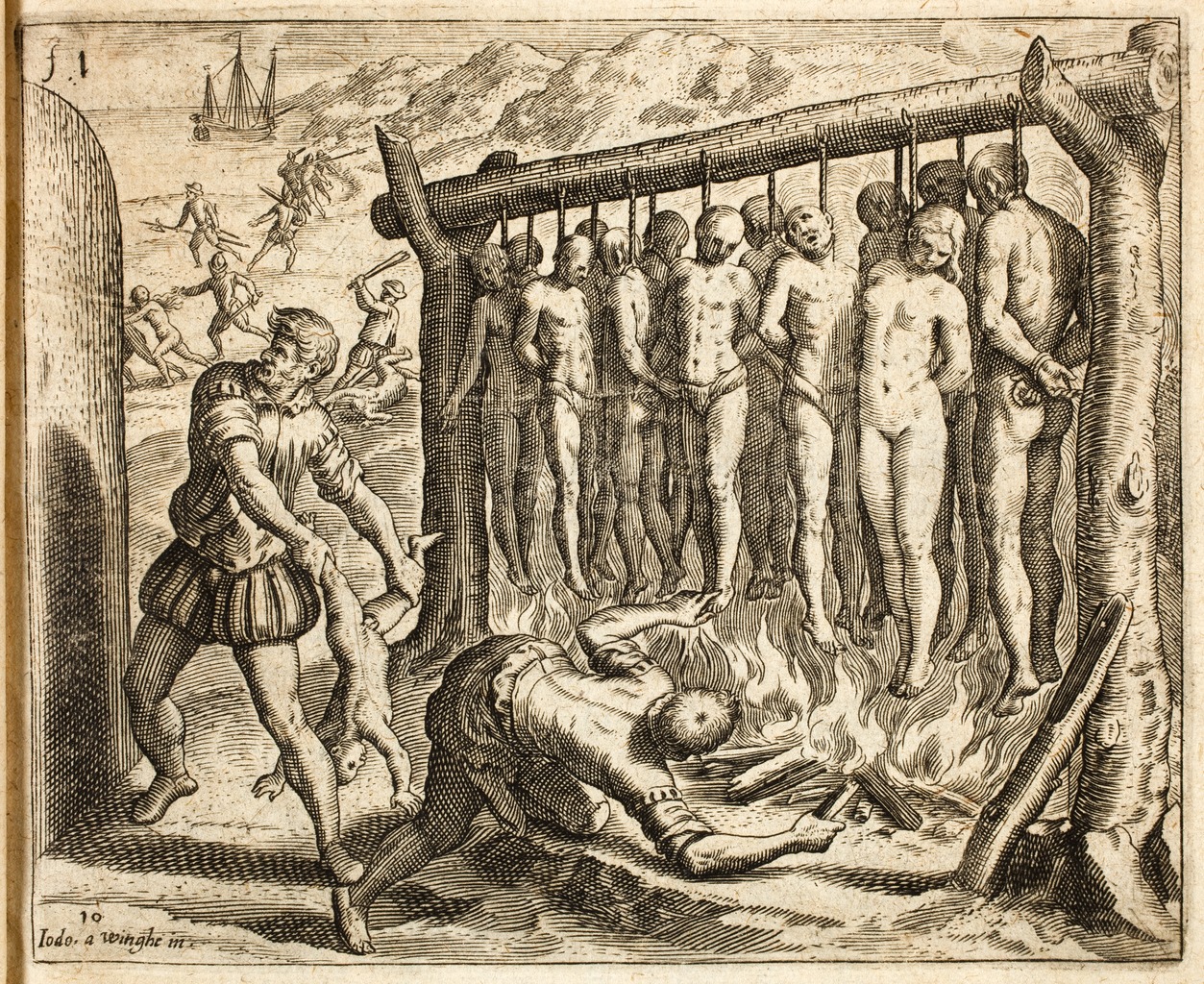
An illustration of Spanish cruelty in Cuba in an edition of Bartolomé de las Casas's 1552 work A Short Account of the Destruction of the Indies.
For the peoples of Abya Yala, this holocaust was not just physical but metaphysical. It meant the obliteration of whole worlds of experience, and their enforced replacement with a European world, an alien reality in which this carnage was somehow acceptable.
For the torments did not end when the settlers declared their independence from European colonial powers. The integration of their new nation-states into a global European-style capitalist order has merely perpetuated the exploitation, immiseration, and dehumanization of indigenous populations, imposing upon them what many now call a condition of racist “coloniality.”
Thus, along with the descendants of African slaves all over the Americas, indigenous peoples continue to be stigmatized and victimized by a systemic racial oppression. They are deemed forever “backward” and “inferior,” forever a “problem” that impedes the forward march of “growth,” “development,” and “progress.”
Likewise, their distinctive worlds of experience, realities which have sustained whole ecologies successfully for centuries, continue to be devalued and dismissed as mere figments of “myth” and “belief.”
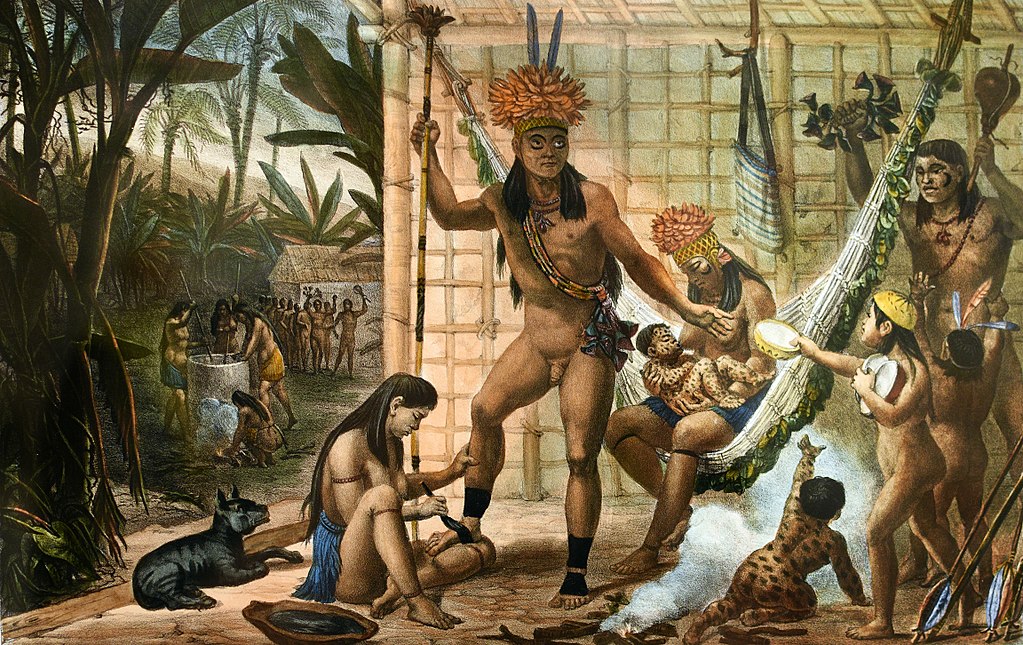
An early nineteenth-century painting by Jean-Baptiste Debret entitled Famille d’un Chef Camacan se préparant pour une Fête, depicts an indigenous Brazilian family preparing for a feast.
As a result of this continuing coloniality, the surviving peoples of Abya Yala are condemned by circumstance to internalize another reality, to know themselves with the Euro-American common sense of their oppressors, as if they and their ancestors had not suffered enough already.
And we historians are complicit in this process. We help to normalize the modern coloniality of knowing and being through the ways we think about and write history. Doubtless, the horrors inflicted on colonized and enslaved peoples across the globe are by now better known and documented than they once were. But the tools of our practice, the devices we use to craft our stories about all past peoples, are still infused with the coloniality which made those horrors so acceptable in the first place.
For example, we force all past peoples to inhabit a single universal scheme of time and space, disregarding all the other chronologies and geographies humans have experienced. We still tend to measure the importance of past peoples by their contributions to “western civilization,” and thus to the making of our own modern capitalist world.
So, we value the histories of white European peoples, like the ancient Greeks, far more than we value the histories of non-white non-Europeans, like the precolonial civilizations of the Americas, Africa, and Asia, even though the latter sustained many millions more human lives across time.
And we all but ignore the “pre-contact” pasts of countless other peoples, from Arctic Inuit to Aboriginal Australians. Apparently, because they did not record their experiences in what we call “writing,” they have no real “history” at all.
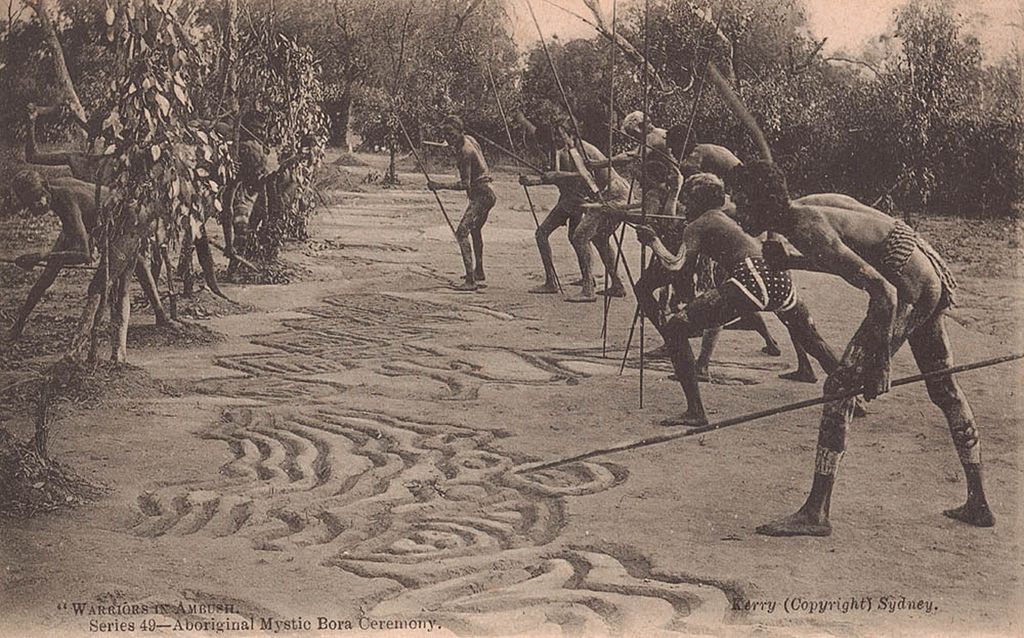
Aboriginal Australian warriors perform the Bora ceremony, photographed between 1900-1927.
But more insidious is the way our conventional practice of history effectively colonizes the basic fabrics of all past realities, western and non-western. Our analytical devices allow us to play God with the lived experiences of non-modern peoples, authorizing us to re-engineer their ways of life to fit our own model of reality.
Standard accounts of classical Athens are typical in this respect. They just take it for granted that the polis was an abstract modern-style societal space, one that divided experience into contradictory realms and fields, like nature and culture, sacred and secular, public and private, and so on. And when the ancient evidence is crammed into these modern compartments, the destruction of a relational way of being human predictably ensues. The real divine governors of a polis ecology become unreal products of the imagination.
Mother Attica herself becomes mere “property,” a “territory,” or a “natural environment.” The unitary Demos, the deathless social body of all male and female Athenians, becomes an aggregate of competitive, self-serving individuals. And the whole ancestral way of life that was once called demokratia becomes a modern style “democracy,” a “political system” in which only males could be “citizens.”
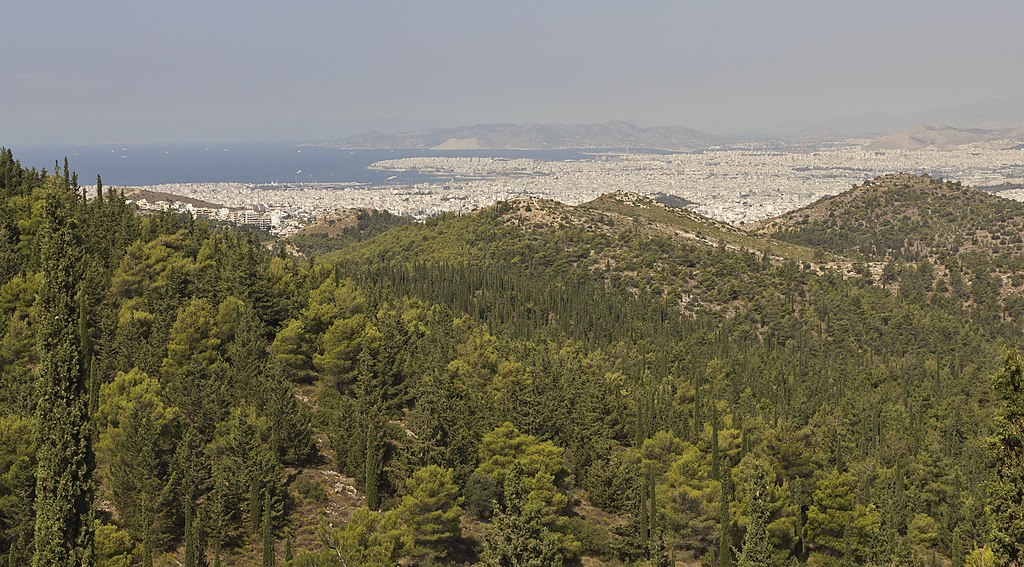
The view from Kaisariani Hill looking towards Athens.
In sum, by imposing a present model of reality on all past worlds, our conventional practice dismembers the real ecologies that sustained the real lives of the peoples we study, before then rebuilding them on alien modern foundations. As a result, our “histories” always end up presenting non-modern polities as immature, underdeveloped versions of a modern nation-state rather than as fully realized versions of themselves.
These accounts thus normalize and naturalize modernity’s bizarre human-centered secular world, along with its narrowly materialist notions of value, growth, and progress. They invalidate all non-modern ways of being human, perpetuating a racist coloniality of knowing and being.
It is time to end this complicity and “decolonize” the past as we know it.
Indigenous peoples have long been pressing the cause of decolonization, especially since the later 1960s. Their ultimate aim is to end modern coloniality by asserting their right to pursue their own ways of life in worlds of their choosing. Historians can become allies in this cause by recognizing that pasts have been lived in a pluriverse of many worlds, not in a universe of one.

A mural commemorating the Occupation of Alcatraz which lasted from 1969-1971 (left). Graffiti on the Alcatraz sign dating from the occupation by the Indians of All Tribes protest group (right).
Becoming an ally means abandoning practices that destroy the essential fabrics of non-modern worlds. It means analyzing those worlds on their own terms, according to their own models of reality. It means restoring to past peoples the power to determine the truths of their own experiences. It means allowing them to decide for themselves what counts as a world.
This pluriversal history should produce accounts of past worlds that are more ethical and more historically meaningful. But can we really believe in the existence of many different worlds? Dare we question objective scientific truths about the nature of reality itself?
What Counts as a World?
As it happens, the idea of an objectively knowable world has long been questioned by authorities in multiple fields, from philosophy and anthropology to science studies, biology, and quantum physics. Many would now agree that reality is in some way relational.

All things are effectively made of their relations with the other things on which their existence depends. This means that we humans are indeed just a “thread in the fabric” of being, much like everything else. We are just outcomes of entanglements with all the other beings and things that make our lives possible.
And if one accepts this relational vision of reality, one must also accept the impossibility of any truly “objective” knowledge of “the world.” For it is simply not possible for us to know a world that is somehow separate from or external to ourselves, as if we could somehow extricate ourselves from its fabrics and view it from outside, from nowhere, like gods.
We will always know the world from a particular somewhere in time and space, from wherever we happen to be entangled. The world we know, and how we know it or “model” it, will always be determined by that particular somewhere, whether it be ancient Egypt, the Amazonian rainforest, or modern Europe.
And if so, no historical world model will ever be more universally or absolutely “true” than any other.
Of course, our modern western model seems universally true to us today because we live by it, enacting it every day of our lives, and it seems to work well in practice. We have been socialized by our schools and societies to take this model entirely for granted, since it is also taken for granted by our capitalist economies, our liberal democracies, our mainstream media and sciences, and all the other major components of our modern western way of life.
The model is simultaneously baked into the tissues of our minds and the fabrics of our environments. And it is through the ongoing interactions between these minds and environments that the effect of a materially self-evident “world” is generated, as if it had really been there all along.
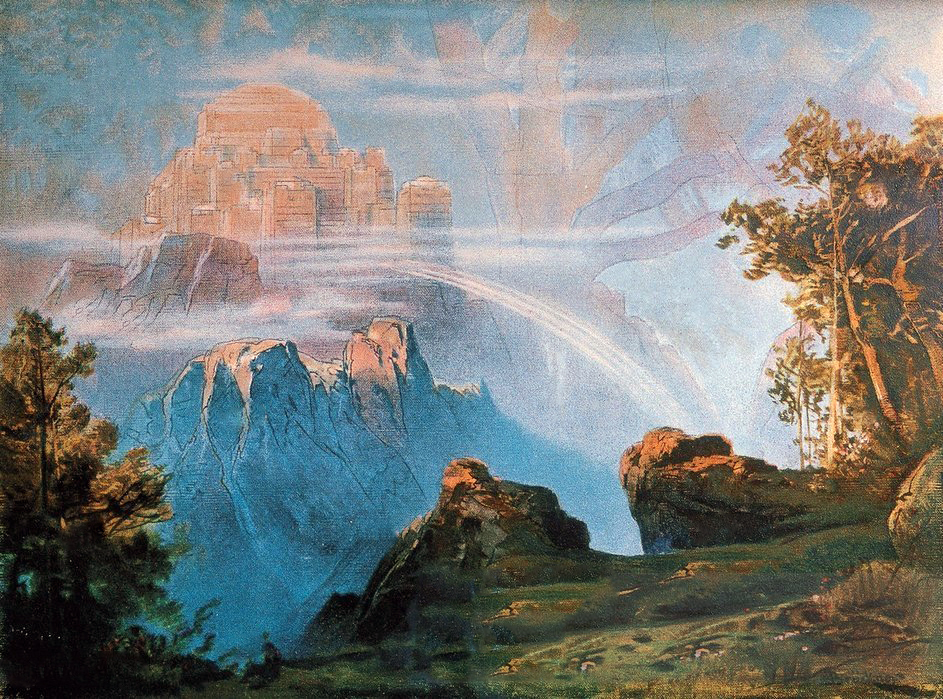
Max Brückner’s 1896 painting Valhalla shows the great hall located in Asgard. The branches of Yggdrasil, the world tree, can be seen in the background.
But this world of ours is no more timeless or universal than any of the other worlds which other minds and environments have conspired to produce across time and space. Every stable way of life entangles human and non-human participants in a process of world-making or “worlding.” And once we recognize that worlding processes are everywhere in history, a pluriverse of many worlds will begin to materialize before our eyes.
What Counts as Life?
There is also a more straightforward way one can press the case for a pluriverse. Instead of deciding what counts as a world by some abstract truth standard, we can apply a more practical ecological standard. We can simply measure the realness of a world by how well it works in practice, by its capacity to sustain human and non-human life.
Of course, there may be all kinds of non-modern practices that we today find abhorrent. But it is also unarguable that non-modern realities have successfully sustained the real lives of many millions of humans for many thousands of years, whether in vast empires or in tiny face-to-face communities. And they have largely done this without inflicting catastrophic damage upon the living fabrics of the Earth.
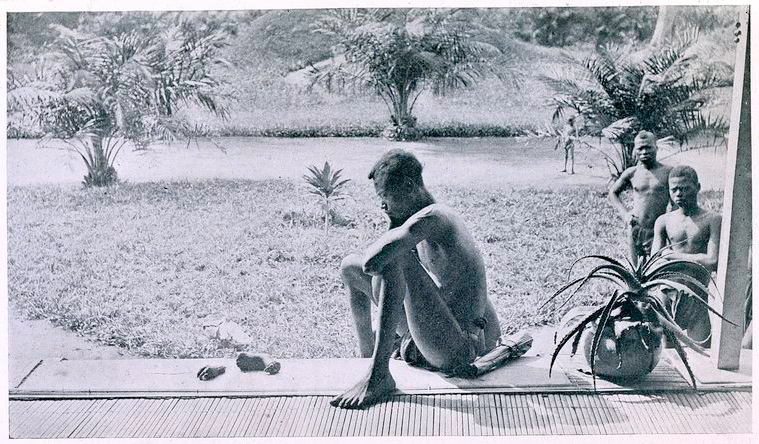
In stark contrast, our strange modern European-style world has imperiled the future of the whole planet in just a few hundred years. For all its technological marvels, it has stoked and unleashed forces which have caused all manner of horrors: genocides and ethnocides across entire continents; the exploitation and racist dehumanization of numerous colonized and enslaved peoples; the nightmares of industrial servitude; two monumentally destructive world wars; the Holocaust; nuclear weapons; epidemics of mental illness and drug addiction; open-cast mining; factory farming; species extinctions; ecological devastation; and global warming.
And all for what? For a world where the richest 26 human individuals now own as much wealth as the poorest 3.6 billion combined?
The evidence is clear enough. In this time of “reckoning,” one can no longer ignore the implications. Our modern western model of the world has failed disastrously in practice.
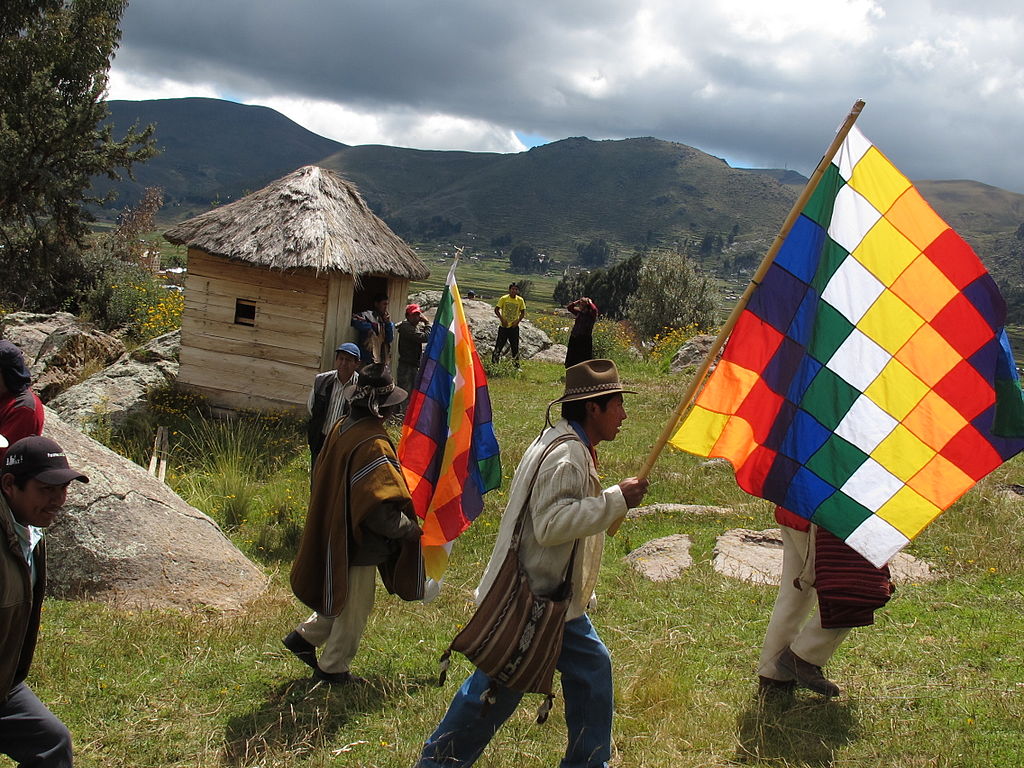
But other real worlds are possible. They have been enacted and lived throughout history. They are being lived right now in what survives of history’s pluriverse, in all those corners of the Earth where sustainable non-modern realities have not yet been obliterated by an unsustainable modernity.
All of us, historians included, need to support the wider cause of decolonization. And all of us need to see that non-modern peoples, past and present, have much to teach us about living in realities that are more balanced and less self-defeating than our own. We need to get over ourselves and start learning from them now, before it is too late.
We urgently need to imagine other ways of being human in other possible worlds.
Amawtay Wasi Cross-Cultural University, Learning Wisdom and the Good Way to Live (UNESCO, 2004).
Greg Anderson, The Realness of Things Past: Ancient Greece and Ontological History (Oxford University Press, 2018).
Karen Barad, Meeting the Universe Halfway: Quantum Physics and the Entanglement of Matter and Meaning (Duke University Press, 2007).
Marisol de la Cadena and Mario Blaser, eds., A World of Many Worlds (Duke University Press, 2018).
Vine Deloria, Jr., God is Red: A Native View of Religion (Fulcrum Publishing, 2003).
Vine Deloria, Jr. The Metaphysics of Modern Existence (Fulcrum Publishing, 2012).
Philippe Descola, Beyond Nature and Culture (University of Chicago Press, 2013).
Roxanne Dunbar-Ortiz, An Indigenous Peoples’ History of the United States. (Beacon Press, 2014).
Arturo Escobar, Designs for the Pluriverse: Radical Interdependence, Autonomy, and the Making of Worlds (Duke University Press, 2018).
Donna Haraway, “Situated Knowledges: The Science Question in Feminism and the Privilege of Partial Perspective.” Feminist Studies 14.3 (1988), 575-599.
Donna Haraway, Staying with the Trouble: Making Kin in the Chthulucene (Duke University Press, 2016).
John Law, “What’s Wrong with a One-World World?” Distinktion: Journal of Social Theory 16.1 (2015), 126–139.
Walter D. Mignolo, The Darker Side of Western Modernity: Global Futures, Decolonial Options (Duke University Press, 2011).
Walter D. Mignolo and Catherine E. Walsh, On Decoloniality: Concepts, Analytics, Praxis (Duke University Press, 2018).
Anibal Quijano, “Coloniality of Power, Eurocentrism, and Latin America.” Neplanta: Views from the South 1.3 (2000), 533-80.
Bernd Reiter, ed., Constructing the Pluriverse: The Geopolitics of Knowledge (Duke University Press, 2018).
Chela Sandoval, Methodology of the Oppressed (University of Minnesota Press, 2000).
David E. Stannard, American Holocaust: The Conquest of the New World (Oxford University Press, 1992).
Waziyatawin Angela Wilson and Michael Yellow Bird, eds., For Indigenous Eyes Only: A Decolonization Handbook (School of American Research Press, 2005).
Sylvia Wynter, “Unsettling the Coloniality of Being/Power/Truth/Freedom: Towards the Human, After Man, its Overrepresentation—an Argument.” New Centennial Review 3.3 (2003), 257-337.
Tyson Yunkaporta, Sand Talk: How Indigenous Thinking Can Save the World (Harper One, 2020).
See also Greg Anderson’s TED talk “What ancient civilizations teach us about reality” https://www.youtube.com/watch?v=1geJGnzJ87Q

